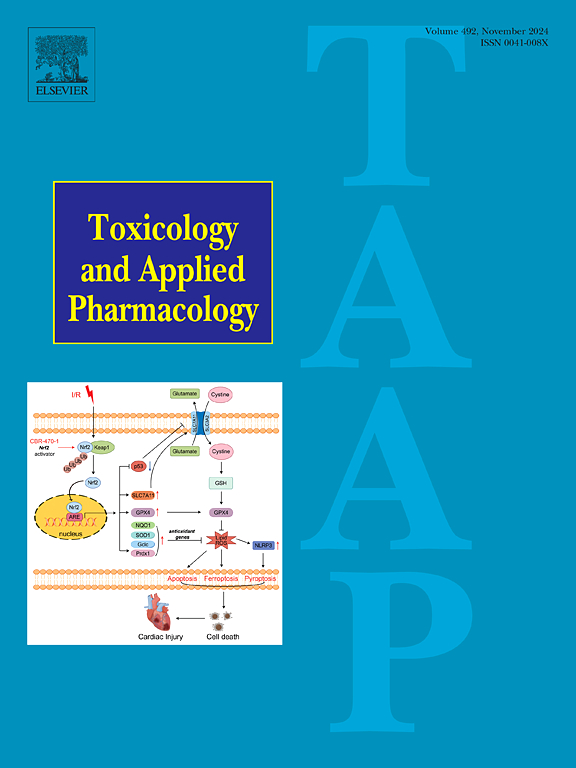H3K9/18乳酸化调节人支气管上皮细胞镍暴露引起的DNA损伤
IF 3.3
3区 医学
Q2 PHARMACOLOGY & PHARMACY
引用次数: 0
摘要
镍是一种众所周知的具有肺癌特性的重金属,因其对细胞代谢、氧化应激和基因表达的影响而被公认。虽然这些细胞改变已经促使研究其对组蛋白修饰的潜在影响,但与组蛋白乳酸化的具体关联仍在探索中。在本研究中,我们证明了镍暴露可诱导人支气管上皮Beas-2B细胞中赖氨酸9 (H3K9)和18 (H3K18)处组蛋白H3的乳酸化,并伴有活性氧(ROS)积累和DNA损伤。通过过表达突变的H3K9R和H3K18R分别实现对H3K9和H3K18乳酸化的抑制,可显著消除镍暴露引起的ROS生成和DNA损伤。这突出了H3K9和H3K18乳酸化在镍诱导的肺毒性中的新的生物学效应。机制研究表明,镍诱导的H3K9和H3K18的乳酸化是通过LDHA表达升高介导的,导致乳酸积累,这分别是通过HIF-1α/c-Jun轴上调LDHA mRNA转录和通过TNF-α介导的HSP70增强LDHA蛋白稳定性引起的。我们的研究结果揭示了镍暴露对组蛋白H3乳酸化的新影响及其通过HIF-1α/c-Jun/LDHA和TNF-α/HSP70/LDHA途径对ROS积累和DNA损伤的生物学影响。这些结果为组蛋白乳酸化在重金属诱导的肺毒性中的作用提供了重要的见解。本文章由计算机程序翻译,如有差异,请以英文原文为准。

H3K9/18 lactylation regulates DNA damage due to nickel exposure in human bronchial epithelial cells
Nickel, a well-known heavy metal with lung carcinogenic properties, is recognized for its effects on cellular metabolism, oxidative stress, and gene expression. While these cellular alterations have prompted investigations into its potential impact on histone modifications, specific associations with histone lactylation remain under exploration. In the present study, we demonstrate that nickel exposure induces lactylation of histone H3 at lysines 9 (H3K9) and 18 (H3K18), accompanied by reactive oxygen species (ROS) accumulation and DNA damage in human bronchial epithelial Beas-2B cells. Inhibition of H3K9 and H3K18 lactylation, achieved by overexpressing mutated H3K9R and H3K18R, respectively, markedly abolishes ROS generation and DNA damage caused by nickel exposure. This highlights the novel biological effects of H3K9 and H3K18 lactylation in nickel-induced lung toxicity. Mechanistic investigations show that nickel-induced lactylation of H3K9 and H3K18 is mediated by elevated LDHA expression, leading to lactate accumulation, which results from the upregulation of LDHA mRNA transcription through HIF-1α/c-Jun axis and enhanced LDHA protein stability via TNF-α-mediated induction of HSP70, respectively. Our findings uncover a novel effect of nickel exposure on histone H3 lactylation and its biological impact on ROS accumulation and DNA damage through the HIF-1α/c-Jun/LDHA and TNF-α/HSP70/LDHA pathways. These results provide significant insights into the role of histone lactylation in heavy metal-induced lung toxicity.
求助全文
通过发布文献求助,成功后即可免费获取论文全文。
去求助
来源期刊
CiteScore
6.80
自引率
2.60%
发文量
309
审稿时长
32 days
期刊介绍:
Toxicology and Applied Pharmacology publishes original scientific research of relevance to animals or humans pertaining to the action of chemicals, drugs, or chemically-defined natural products.
Regular articles address mechanistic approaches to physiological, pharmacologic, biochemical, cellular, or molecular understanding of toxicologic/pathologic lesions and to methods used to describe these responses. Safety Science articles address outstanding state-of-the-art preclinical and human translational characterization of drug and chemical safety employing cutting-edge science. Highly significant Regulatory Safety Science articles will also be considered in this category. Papers concerned with alternatives to the use of experimental animals are encouraged.
Short articles report on high impact studies of broad interest to readers of TAAP that would benefit from rapid publication. These articles should contain no more than a combined total of four figures and tables. Authors should include in their cover letter the justification for consideration of their manuscript as a short article.

 求助内容:
求助内容: 应助结果提醒方式:
应助结果提醒方式:


